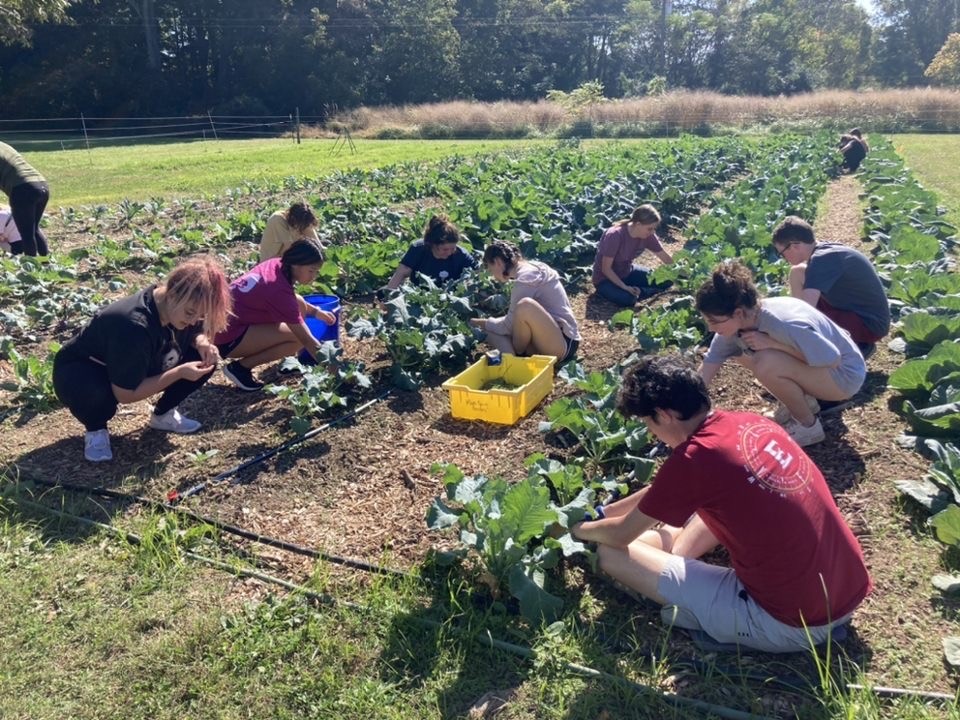Immersive learning is an overarching strategy to teaching and learning where certain qualities or conditions are necessary components. At LEARNS.EDU.VN, we aim to explore the definition, benefits, and applications of this dynamic approach to education. Discover a multitude of in-person, real-world, and technology-driven experiences that amplify the learning process, including situated learning, authentic engagement, and professional development.
1. Understanding Immersive Learning
Immersive learning is not just one specific teaching method; it’s a comprehensive approach that can be applied across various disciplines and learning environments. It encompasses a wide range of experiences designed to deeply engage the learner.
1.1. Defining Immersive Learning
Immersive learning can be described as an overarching teaching and learning strategy, not tied to a particular subject or career path, but marked by essential characteristics. These include authentic experiences, deep engagement, and a real-world context. It’s learning that is more than theoretical; it’s actively doing and experiencing.
1.2. Immersive Learning vs. Traditional Learning
| Feature | Immersive Learning | Traditional Learning |
|---|---|---|
| Engagement | High, active participation | Passive reception of information |
| Context | Real-world, authentic situations | Classroom-based, often abstract |
| Focus | Holistic, encompassing emotional and practical aspects | Primarily cognitive, focused on knowledge acquisition |
| Autonomy | Learner-led, with choices and decisions | Teacher-led, with structured curriculum |
| Retention | Stronger due to experiential nature | Can be weaker without practical application |
| Problem-Solving | Emphasizes critical thinking and application | Focuses on memorization and recall |


1.3. Key Characteristics of Immersive Learning
Immersive learning is characterized by six key qualities that differentiate it from other teaching methods:
- Time and Focus: Dedicated periods of sustained engagement with minimal distractions.
- Authentic and Situated Learning: Real-world tasks and environments that directly relate to the learning material.
- Autonomy and Agency: Learners have control over their learning process, making independent decisions.
- Cognitive Dissonance: Challenges learners’ existing beliefs, prompting deep reflection.
- Reflection: Facilitated processes to connect immersive experiences to broader learning and life contexts.
- Facilitation and Guidance: Expert guidance to navigate complex learning environments and potential dissonance.
1.4. The Spectrum of Immersive Experiences
Immersive learning can range from short, focused activities to long-term engagements. The intensity of each of the six key characteristics can vary depending on the specific learning experience. For example, a short workshop might have high intensity in time and focus but lower intensity in autonomy, while a semester-long internship might have high intensity in autonomy and authenticity.
2. The Core Components of Immersive Learning
Each component plays a vital role in creating a holistic and impactful educational experience.
2.1. Time and Focus: The Depth of Engagement
Time is a critical variable in immersive learning, affecting how deeply learners can engage with specific tasks. According to Soares (1998), the amount of time, the frequency of activities, and the number of competing tasks all influence the learning experience. This is a multifaceted element, divided into three sub-characteristics:
- Degree of Focus: Emphasizes minimizing distractions to allow learners to concentrate on a single task.
- Time on Task: Refers to the duration spent engaging with a learning activity. Studies by Gullatt (2006) and van Gog (2013) suggest that longer, sustained learning periods are more effective.
- Continuity of Learning: Focuses on the frequency of learning experiences, ensuring that knowledge remains fresh and builds upon itself, preventing loss of understanding.
2.2. Authentic and Situated Learning: Bridging Theory and Practice
Authenticity involves direct engagement with real-world contexts and communities, making learning tangible and relevant. Hill and Hannafin (2001) and Herrington and Herrington (2006) emphasize that authentic learning experiences should closely mimic real-life situations relevant to the course of study. Situated learning, as Lave and Wenger (1991) propose, posits that learning is embedded within the context in which it occurs.
Authentic learning allows students to engage directly with relevant people and communities, fostering higher-order thinking skills such as analysis, application, and synthesis.
2.3. Autonomy and Agency: Empowering the Learner
Immersive learning allows learners greater control over their learning process, promoting independence and self-direction. Students are encouraged to make decisions and seek guidance from various sources, developing essential self-management skills.
Agency, as defined by Klemenčič (2015), relates to an individual’s ability to influence their situation. Immersive learning connects actions with outcomes, reinforcing the learner’s control over their educational journey. Vaughn (2020) highlights that this approach encourages active participation rather than passive reception of information.
2.4. Cognitive Dissonance: The Catalyst for Growth
Learning can be a disruptive process that challenges our worldview, as noted by Mezirow (1978). Cognitive dissonance occurs when new information conflicts with existing beliefs, prompting critical evaluation and adaptation. Hoskins (2013) suggests that some level of discomfort may be necessary for transformative learning.
Immersive experiences in authentic settings can increase the potential for dissonance, pushing students to confront and reconcile conflicting ideas. This discomfort can be a powerful catalyst for deeper understanding and personal growth.
2.5. Reflection: Processing and Connecting Experiences
Reflection is essential for processing immersive experiences and connecting them to broader learning and life contexts. Kiely (2005) emphasizes the importance of reflection in facilitating difficult realizations and changes in previously held beliefs. Brookfield (2016) highlights the necessity of critical reflection for deeper understanding.
Facilitated reflective practices help students navigate complex experiences, encouraging them to analyze and integrate new knowledge effectively.
2.6. Facilitation and Guidance: Navigating the Learning Journey
Guidance and facilitation are crucial for navigating the variable nature of immersive experiences, as Margalef and Roblin (2016) note. Instructors play a key role in scaffolding student learning, aligning the learning environment with specific outcomes.
Skilled facilitators orient and guide students, ensuring that the immersive experience is beneficial rather than counterproductive. Rogers (1969) describes the facilitator as a “guide on the side,” supporting and co-learning with students.
3. Why Immersive Learning Matters: The Benefits
Immersive learning offers numerous advantages that can enhance educational outcomes.
3.1. Increased Engagement and Motivation
By placing learners in realistic contexts and providing opportunities for active participation, immersive learning fosters greater engagement and intrinsic motivation. Students are more likely to invest in their learning when they see its direct relevance to their lives and future careers.
3.2. Deeper Understanding and Retention
Experiential learning leads to a deeper understanding of concepts and improved retention of information. When students actively apply knowledge in real-world scenarios, they are better able to internalize and recall what they have learned.
3.3. Development of Critical Thinking Skills
Immersive learning encourages students to think critically and solve problems in complex, unstructured environments. They must analyze situations, make decisions, and adapt to changing circumstances, developing essential skills for success in the 21st century.
3.4. Enhanced Collaboration and Communication
Many immersive learning experiences involve collaboration with peers, community members, or professionals. These interactions enhance communication skills, teamwork abilities, and the capacity to work effectively in diverse groups.
3.5. Increased Cultural Awareness and Global Competence
Immersive experiences in diverse cultural settings can broaden students’ perspectives and promote cultural awareness. They develop the ability to navigate different cultural norms, communicate effectively across cultures, and appreciate global interconnectedness.
3.6. Improved Career Readiness
By providing opportunities for hands-on experience and professional development, immersive learning enhances students’ career readiness. They gain valuable skills, build professional networks, and develop a strong sense of their career goals.
4. Types of Immersive Learning Experiences
Immersive learning manifests in many forms, each with its unique approach and benefits.
4.1. Community-Based Learning
Community-based learning integrates community interactions into the learning process.
- Service Learning: Students partner with and work within a community to learn relevant material.
- Social Innovation: Developing business-oriented solutions to social challenges within a community.
- Teacher Education: Student teaching and practicum experiences in real classroom settings.
4.2. Global Education
Global education combines disciplinary learning with intercultural experiences away from the university.
- Study Abroad: Learning in an international setting.
- Study USA: Learning away from campus but within the United States.
4.3. Hands-On Research Practice
Hands-on research connects disciplinary learning with real-world contexts.
- Field Research: Conducting research in natural or social settings.
- Teacher Education Practicum: Observation-based learning in real classrooms.
- Community-Based Research: Research conducted in partnership with community organizations.
4.4. Work-Integrated Learning
Work-integrated learning professionalizes education, engaging students in authentic work settings.
- Internships: Earning course credit for working in a professional environment.
- Co-op Programs: Full-time professional learning experiences.
- Clinical Rotations: Specific to health sciences, involving direct patient care.
4.5. Simulated Learning
Simulated learning uses designed environments to mimic real-world professional settings.
- Role Playing: Students act as participants in simulated scenarios.
- Standardized Patients: Actors trained to simulate medical conditions for training purposes.
- Medical Simulations: Using manikins and technology to simulate medical procedures.
- Flight Simulators: Used in aviation education to simulate flight conditions.
4.6. Combinations of High-Impact Practices
Combining immersive learning practices enhances learning potential.
- Community-Based Participatory Research: Combines community engagement with hands-on research.
- International Service Learning: Integrates intercultural learning with community service in an international location.
4.7. Structural Modifications
Structural modifications strategically manipulate course and program structures to enhance learning.
- Block Scheduling: Courses are offered in shortened, intensive blocks.
- Trimesters: Academic year divided into three terms, with students taking multiple courses each term.
- Hybrid Structures: Combining single-course blocks with longer, semester-like terms.
5. Examples of Immersive Learning in Action
Numerous institutions and programs exemplify the principles of immersive learning, each offering unique approaches and outcomes.
5.1. Block Curriculum: Colorado College and University of Montana Western
Colorado College and the University of Montana Western are two institutions that have fully embraced the block curriculum. Students take one course at a time, in intensive 3 1/2 week blocks. This format encourages complete immersion in a single subject, enhancing focus and depth of understanding.
5.2. Elon University: Interactive Media “Fly-In” Course
Elon University’s Interactive Media graduate program includes a global service learning course taught during the January term. This course allows students to apply classroom knowledge in professionally and interculturally challenging environments, providing high levels of immersion through extended time, focus, and authentic experiences.
5.3. UC-Riverside School of Medicine: LACE Program
The Longitudinal Ambulatory Care Experience (LACE) program at UC-Riverside School of Medicine involves students in direct patient care from their third week of medical school. This hands-on approach provides heightened levels of time-on-task and opportunities for learning continuity.
5.4. Purdue University: HDFS Internship Program
Purdue’s Human Development and Family Studies Internship Program is a capstone experience where students gain direct knowledge of the field and practice skills in a 40-hour-per-week internship. This immersive experience is mentored by both a professional preceptor and a faculty facilitator.
6. Addressing Challenges and Maximizing Impact
While immersive learning offers significant benefits, its successful implementation requires careful consideration of potential challenges.
6.1. Overcoming Structural Barriers
Traditional higher education structures can pose barriers to the adoption of immersive practices. Overcoming these barriers requires institutions to be flexible and supportive of innovative teaching methods.
6.2. Providing Adequate Support and Resources
Faculty members need adequate support and resources to design and facilitate effective immersive learning experiences. This includes training, funding, and access to relevant tools and technologies.
6.3. Balancing Control and Autonomy
Finding the right balance between instructor control and student autonomy is crucial. Instructors should provide guidance and structure while allowing students the freedom to explore and make decisions.
6.4. Assessing and Evaluating Immersive Learning
Developing effective methods for assessing and evaluating immersive learning outcomes is essential. This may involve using qualitative and quantitative data to measure student engagement, learning gains, and skill development.
7. The Future of Immersive Learning
Immersive learning is poised to play an increasingly important role in higher education. As technology advances and the demands of the workforce evolve, immersive approaches will become even more valuable.
7.1. The Role of Technology
Emerging technologies such as virtual reality (VR), augmented reality (AR), and artificial intelligence (AI) offer new opportunities to create immersive learning experiences. These technologies can simulate real-world environments, provide personalized feedback, and enhance student engagement.
7.2. The Importance of Lifelong Learning
In today’s rapidly changing world, lifelong learning is essential. Immersive learning can help individuals develop the skills and mindset needed to adapt to new challenges and opportunities throughout their lives.
7.3. The Need for Interdisciplinary Collaboration
Addressing complex global challenges requires interdisciplinary collaboration. Immersive learning can bring together students and faculty from different disciplines to work on real-world problems, fostering innovation and creativity.
8. Discover More at LEARNS.EDU.VN
At LEARNS.EDU.VN, we believe in the power of immersive learning to transform education and empower learners.
8.1. Explore Our Resources
Visit our website to explore a wide range of articles, guides, and resources on immersive learning. Learn from experts, discover innovative practices, and find inspiration for your own educational journey.
8.2. Connect with Our Community
Join our community of educators, learners, and innovators. Share your experiences, ask questions, and collaborate with others who are passionate about immersive learning.
8.3. Enhance Your Skills
Discover courses from LEARNS.EDU.VN that will help you enhance the skills and knowledge required for success. At LEARNS.EDU.VN, we want you to achieve your full potential.
9. Frequently Asked Questions (FAQs) About Immersive Learning
- What is the main goal of immersive learning?
To deeply engage learners through real-world contexts and active participation, enhancing understanding and retention. - How does immersive learning differ from traditional education?
Immersive learning emphasizes active, real-world experiences, while traditional education often focuses on passive learning in a classroom setting. - What are the key characteristics of effective immersive learning experiences?
Effective experiences involve time and focus, authenticity, autonomy, cognitive dissonance, reflection, and facilitation. - Can immersive learning be used in online education?
Yes, virtual and augmented reality technologies can create immersive online learning experiences. - What role does the instructor play in immersive learning?
Instructors act as facilitators, guiding students through the learning process and providing support. - How can schools integrate immersive learning into their curriculum?
By incorporating community-based projects, simulations, internships, and other experiential activities. - What are the benefits of immersive learning for students with diverse learning needs?
Immersive learning can provide personalized and engaging experiences that cater to different learning styles and abilities. - How can students reflect on their immersive learning experiences?
Through journaling, group discussions, and presentations that connect their experiences to course content. - What technologies are commonly used in immersive learning environments?
Virtual reality, augmented reality, and interactive simulations are frequently used. - How can I find more resources about immersive learning?
Visit LEARNS.EDU.VN and explore our articles, guides, and community forums for more information.
10. Contact Us
For more information, contact LEARNS.EDU.VN today.
Address: 123 Education Way, Learnville, CA 90210, United States
Whatsapp: +1 555-555-1212
Website: LEARNS.EDU.VN
Discover the power of immersive learning and unlock your full potential with learns.edu.vn.
